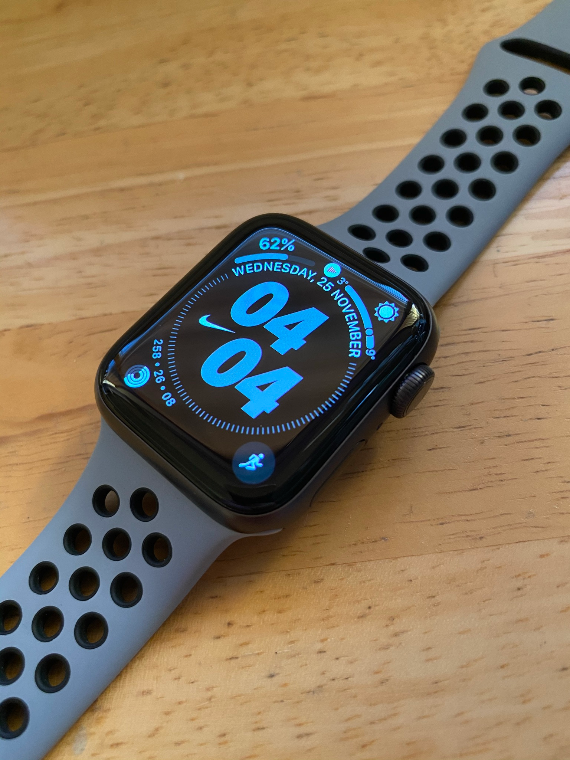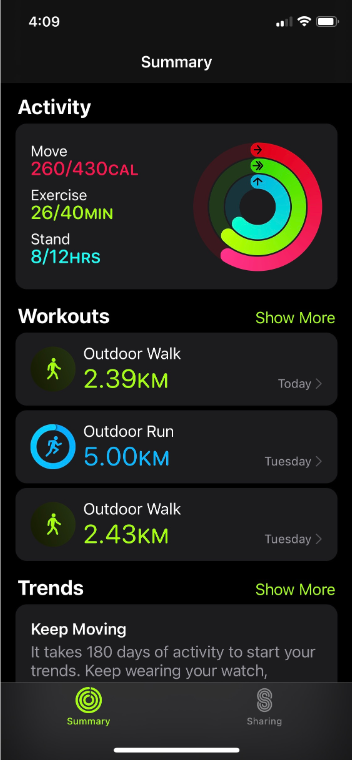Having spent most of the year wearing a Fitbit Charge 3, I came to realise that I loved the fitness related features of the device but wanted more from it. What was particularly lacking for me was the lack of built in GPS, and lack of ability to listen to music/podcasts while running. I wanted a device that would provide all the fitness related features of the Fitbit but would also include features that I relied on my phone for.
Being within the Apple ecosystem for most of my devices, the obvious choice was the Apple Watch. I have previously wrote on this website that I wasn’t particularly interested in the Apple Watch as a device. I liked the idea of being able to leave my phone behind me, but didn’t like the idea of having another device to manage. Most of this is still true, but where the Apple Watch really excels for me is the combination of fitness and media features.

The model I went for is a Space Grey Series 6 Nike Edition GPS, 40mm. I have narrow wrists, so the 40mm size is perfect for me. I decided to get the Nike Edition as I liked some of the exclusive watch faces, and really like the Nike bands. I chose the Obsidian Mist/Black colour for the band which I think suits the Space Grey in particular. There’s not a lot to say about the design of the watch. It hasn’t changed a whole lot since the Apple Watch was first released five years ago.
WatchOS is easy to use and can be almost completely managed from the Watch app for iPhone. There are only a handful of apps I use on the Watch on a regular basis, namely Workout, Dark Sky and Overcast for tracking exercise, checking weather and listening to podcasts. As expected, the Watch handles notifications from iPhone seamlessly by gently vibrating when you get notifications instead of waking up the phone. This interaction is nicer than I expected, as constant notifications was one of the reasons I hadn’t been particularly enthusiastic about the watch.

My favourite use of the watch is for tracking runs while listening to podcasts. I can load podcasts (or music) onto the watch, connect my Airpods and go for a run without needing to bring my phone. The run is fully tracked with GPS, heart rate, pace and more. It makes a huge difference to have all of this managed without having to think about it. It’s also simple to set up. If I want to go for a 5km run, I set that as my target, click play on the podcast and away I go. Every kilometre ran will bring a light vibration from the watch, and at any point I can glance at the time, distance ran etc. It’s a much more freeing way of going for a run, allowing me to just enjoy a podcast without thinking “how many laps are left” or picking a specific route that I know is the exact 5km distance.
While the Apple Watch is much more capable than the Fitbit Charge 3 in most areas, as expected there are some drawbacks. The biggest drawback is of course battery life. My Series 6 lasts just about a full day with some walking/running and frequent use during the day. By contrast, I only had to plug in the Charge 3 about once a week. This is not surprising but something to be aware of if you are interested in a smartwatch versus a fitness band. It can also serve as a distraction from time to time. Notifications filter from the phone to the watch so you can quickly find yourself getting overwhelmed by this. The good news is this is all configurable, so you can limit what notifications you see.
Combining impressive health and fitness features 1 with phone-like media features, the Apple Watch is a powerful device that can be used in lots of different settings. It’s equally at home on your wrist while exercising as it is in more formal settings. After a difficult first few years of underpowered hardware and limited software, the Apple Watch is now an easy recommendation to make.
-
I didn’t even mention all of the health related features built into the watch. There is a heart rate sensor, blood oxygen monitor, ECG app and much more. ↩